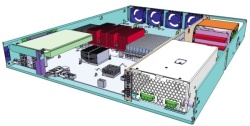Open Compute Project: Facebook publishes specifications for efficient data centres

Facebook technicians have spent a full year developing an especially efficient data centre. The company has now published the results within its Open Compute Project. The information ranges from technical specifications for mainboards and server power packs, to towers, cabinets, data, and transformer types for connections to the local utility's high-voltage grid. Facebook plans to share its findings with industry and invites the community to take part in development.

![]() Two racks full of Open Compute servers.
Two racks full of Open Compute servers.
Source: Open Compute Project
Facebook says energy efficiency was a decisive criterion in designing its data centre; losses were to be kept to three per cent of the electricity provided. Towards this goal, Facebook has left behind the usual conventions. For instance, all of the server power packs only provide 12.5 volts of DC, with a (48-volt) DC connection for a local UPS unit installed behind each cabinet; in normal operation, the power packs run on 277 volts AC instead of the 120 volts common in the US. The cabinets, which consist of three 19-inch racks each, have a three-phase connection with 480/277 volt RMS supply.
At the 480-volt voltage level, energy is distributed throughout the data centre; this is where auxiliary generators and battery-based UPS units, which were also optimised, are connected. The latter have 48-volt battery packs to reduce line losses, which would be greater with the usual 12-volt packs. Normally, however, two 115-kilovolt high-voltage transformers supply power at the 480-volt level.

![]() A mainboard with a special design.
A mainboard with a special design.
Source: Open Compute Project
Facebook even had its main boards tailor-made. Not only does it make do with the single DC supply mentioned above, but it also has output connections at exactly specified points along with a PCIe-x16 slot for a riser card so that a slot is above each of the connection terminals with onboard connectors. Facebook aims to use these specifications to optimise airflow and cabling.
Unfortunately, the power packs, main boards, towers, and cabinets specified are not on sale anywhere, so the benefits of Facebook's approach is currently limited for other firms, though they could always use the specifications in their own research.

![]() The rack chassis has special dimensions.
The rack chassis has special dimensions.
Source: Open Compute Project
Operators of European data centres will probably not find much new in Facebook's insights anyway. For instance, 1&1 in Germany has been using a medium-voltage level of 20 kV for years now within its data centre in Karlsruhe, which reduces current well below Facebook's level at the same power consumption. At this voltage level, diesel generators on the building's roof also provide emergency power. Only just before the USPs does the 400-volt level commonly used in Europe begin, with which individual server rooms are powered. 1&1 therefore does not require special power packs for its servers.
See also:
- Facebook Launches Open Compute Project, press release from Facebook.
(crve)
![Kernel Log: Coming in 3.10 (Part 3) [--] Infrastructure](/imgs/43/1/0/4/2/6/7/2/comingin310_4_kicker-4977194bfb0de0d7.png)

![Kernel Log: Coming in 3.10 (Part 3) [--] Infrastructure](/imgs/43/1/0/4/2/3/2/3/comingin310_3_kicker-151cd7b9e9660f05.png)
















